EDITOR’S NOTE: With my WARNER CLUB NEWS posts finished, I’ll take a break for the next few weeks before plunging into another series of animation studio newsletters. Look for that to resume on September 10th. In the meantime, why not post a golden age cartoon that none of you have ever seen before, featuring some of the top talents of the era.

Two years ago, our colleague Don Yowp posted about this cartoon on his must-read Tralfaz blog – and I urge you to read his post for much information that he (with input from CR contributor Jonathan Boschen) relays about producer Oscar Productions and distributor Planet Pictures.
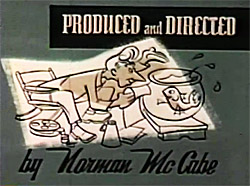 In a nutshell, both companies were formed in the wake of the post-war era – an era that also begat Impossible Pictures (Jerky Journies), John Sutherland Productions (Daffy Ditties) and UPA. The idea of both companies (Planet and Oscar) seemed to be trying to produce pictures at a lower budget – simply by going to a smaller, cheaper 16mm format.
In a nutshell, both companies were formed in the wake of the post-war era – an era that also begat Impossible Pictures (Jerky Journies), John Sutherland Productions (Daffy Ditties) and UPA. The idea of both companies (Planet and Oscar) seemed to be trying to produce pictures at a lower budget – simply by going to a smaller, cheaper 16mm format.
Luckily, some of the best artists were available to the newly formed Oscar Productions to make this “pilot” film. Looney Tunes director/animator Norm McCabe, who began freelancing upon his military discharge, found himself back in the director’s chair – this time acting as a producer as well. Dana Coty (who gets a co-writing credit on Famous Studios Lulu In Hollywood) was hired to form a story; Willis Pyle and Harry Love were borrowed to animate most of the picture; Future UPA artisans Abe Liss and Bob McIntosh did layout and background (with Mary Sheridan); Puppetoon (and future Lantz) composer Clarence Wheeler provided a score; and voice-over veteran Frank Graham did vocals.
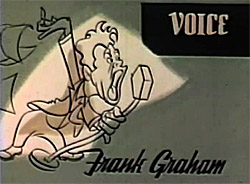 The end result – as you will see – is an average cartoon. Somewhere inbetween a routine Walter Lantz 1940s effort and a Screen Gems Color Rhapsody. Nothing to distinguish it from mediocre. Even the lead character’s voice is the poorest characterization I’ve ever heard Frank Graham intone (and I’m a huge fan of Graham’s voice work elsewhere).
The end result – as you will see – is an average cartoon. Somewhere inbetween a routine Walter Lantz 1940s effort and a Screen Gems Color Rhapsody. Nothing to distinguish it from mediocre. Even the lead character’s voice is the poorest characterization I’ve ever heard Frank Graham intone (and I’m a huge fan of Graham’s voice work elsewhere).
The whole premise of the film seems misguided and unfocused. The unappealing lead character, Professor J. Waldo Purrington, is some sort of variation on Pinocchio’s Honest John (aka J. Worthington Foulfellow). His efforts to honestly “steal” a fish are unfunny – and if this is supposed to be a “message” film, the message is right there in the title, what more is needed? Trivial side note: the address of the Professor’s home is the actual address of Oscar Productions in Hollywood.
Did they really shoot this film in 16mm? Based on advertising in several trade magazines, Oscar Productions attempted to make back its costs by selling long term leases (5 years for $150) to 16mm venues. If this had any success, why aren’t there any prints of this film around? Methinks the whole venture was a major failure. With all that said, here is the only copy available of Honesty Is The Best Policy – Mike Kazaleh uses his expert eye to determine additional animation credits below the video. Enjoy!
Mike Kazaleh Says: “Upon closer inspection of the print… The original camera element really is 16mm reversal stock. The scenes are cut together with big cement splices!
“Also I can positively ID Cal Dalton as having animated two scenes. The very last scene looks like Norm himself animated it. There are a few bits that may be Phil Monroe’s work – and I spotted two scenes that I think may be Rudy Larriva’s work. I also suspect that Emery Hawkins may have contributed as well.
“Norm’s expressions and overall timing are evident throughout, but I don’t think he animated much except the finale. The fish monger has a resemblance to Willy Pyle’s “Gunner Joe” from the flight training films, but with more hair and a mustache.”
“Here’s a few frame grabs with uncredited animators that I’ve positively identified…
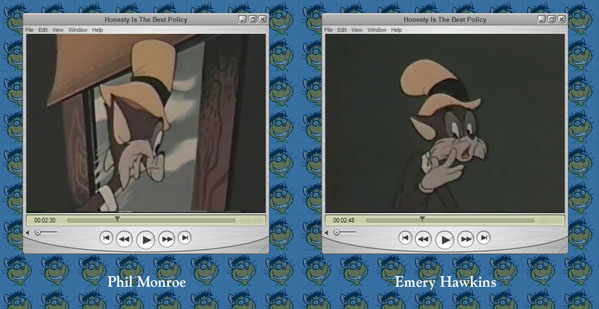
Phil Monroe (at 2:30) • Emery Hawkins (at 2:48)
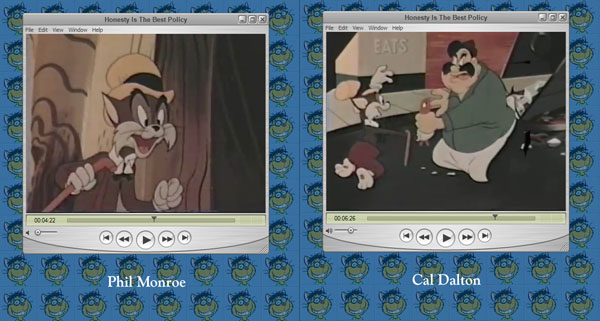
Phil Monroe (at 4:22) • Cal Dalton (6:26)
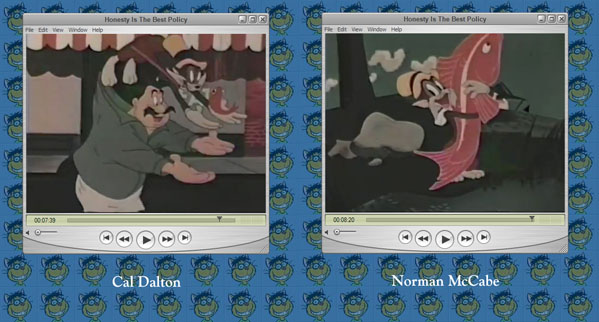
Cal Dalton (at 7:39) • Norm McCabe (8:20)
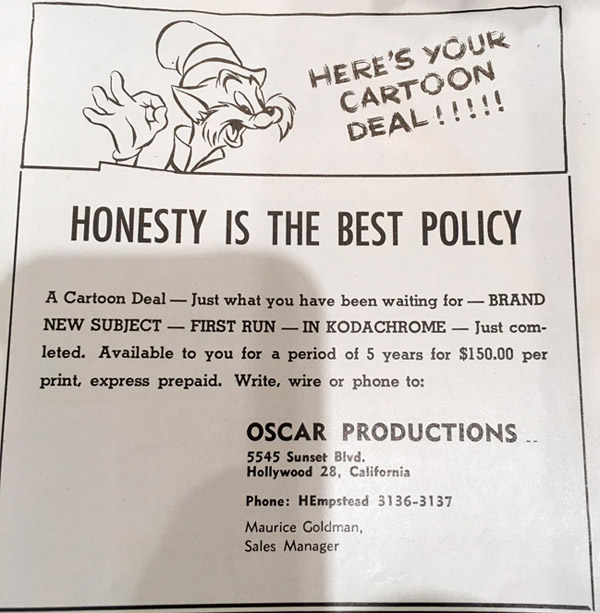
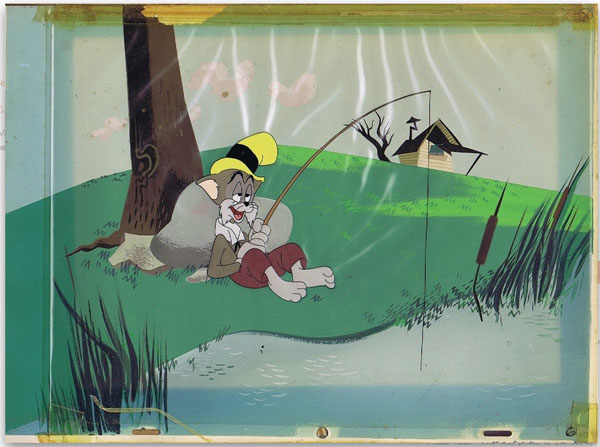
An original cel-set up from “Honesty Is The Best Policy” – courtesy of The Cricket Gallery.


 Jerry Beck is a writer, animation producer, college professor and author of more than 15 books on animation history. He is a former studio exec with Nickelodeon Movies and Disney, and has written for The Hollywood Reporter and Variety. He has curated cartoons for DVD and Blu-ray compilations and has lent his expertise to dozens of bonus documentaries and audio commentaries on such. Beck is currently on the faculty of CalArts in Valencia, UCLA in Westwood and Woodbury University in Burbank – teaching animation history. More about Jerry Beck [
Jerry Beck is a writer, animation producer, college professor and author of more than 15 books on animation history. He is a former studio exec with Nickelodeon Movies and Disney, and has written for The Hollywood Reporter and Variety. He has curated cartoons for DVD and Blu-ray compilations and has lent his expertise to dozens of bonus documentaries and audio commentaries on such. Beck is currently on the faculty of CalArts in Valencia, UCLA in Westwood and Woodbury University in Burbank – teaching animation history. More about Jerry Beck [



































I love the fish monger character Graham does, especially the laughing fit….I think the main voice he is doing for the cat is based on one of his occasional radio characters he did on NIGHTCAP YARNS, his five nights a week radio show where he played all the roles. In pacing and atmosphere this is very much like a Screen Gems of the 1944-46 period.
I can see why this didn’t go anywhere. Despite the great talent behind it, it’s not funny! Even Lantz had better comedic timing.
Jeez, I’ve seen funnier Squiddly Diddly cartoons. Pretty sad for the 1940s.
Passable art and animation, I’ll give it that.
Nonetheless… thanks for the look at a rarity!
I do like the back grounds and character designs, but the cartoon is alright.
BTW- Is it me or is Clarence Wheeler one of the most boring music composers ever?
What about his work on the Puppetoons?
Bears s strong resemblance to “Doc”, a Walter Lantz character who made a couple of impact-free appearances around 1960.
I’d love to be able to identify Willy Pyle’s animation better. When I visited him around 2011, he recalled animating the scene with Magoo on skis in “The Ragtime Bear”, as well as the Dr. Seuss Ford commercials in their entirety.
Willis Pyle also animated the wonderful scene in Gerald McBoing-Boing where Gerald acts in the western radio show, including the “gallop away” sound effects at the end of his scene. Pyle made us believe that Gerald actually produced all the sounds vocally, quite a feat of animated acting!
To me, Purrington looks to be a direct descendant of Missing Lynx from McCabe’s Confusions of a Nutzy Spy.
Tonally, I found this film more reminiscent of one of the “Animaland” cartoons, than those by Screen Gems or Lantz. Visually pleasing, but VERY slow-moving, with thin characterizations and “gags” that just don’t hit the mark or are nonexistent. I like the descriptive drawings in the opening, however. A predecessor to the credits in the Shull Bonsall version of Crusader Rabbit, and in Beany and Cecil.
Thanks Jerry for showing us some obscure Golden Age cartoon history. Yes you are right, the cartoon isn’t very good. Reminded me of Columbia’s “Giddy Yapping” and others of its ilk.
McCabe was never the strongest director at WB, but there at least he had access to some of the best storymen in the industry. A Mike Maltese or Tedd Pierce would have taken the same premise and hit it out of the park.
Excellent post!
The fact that someone thought there was a need for original product for 16mm theaters is curious. I suppose the big distributors gave them short shrift – maybe there was a long wait for the 16mm versions of major studio releases to become available. Just a guess.
Planet Pictures was set up to market original 16mm features and featurettes to rental libraries, mainly Westerns and kiddie-oriented productions; I believe they used Cinecolor for their feature prints. My late friend Keith Smith of Modern Sound Pictures in Omaha still had some well-worn Planet prints in his library decades later, so it might be presumed that renters who leased the pictures might have been offered a buyout option as well.
That second-to-last screengrab looks way more like Hawkins than Dalton (angle of the eyes, construction of the hands, stretched pose, lift of the smile).
OK just watched that scene. Cal Dalton for sure at 7:38.
Also pretty sure I saw Pat Matthews at 4:56.
Wow that was a slog of a cartoon. The animation was nice but the rest of it was on par with the Columbia Rhapsodies…
I do believe that the Emery Hawkins scenes are done by Paul Smith. The style looks similar to what he did at Lantz.
Well, I laughed a couple of times. It might’ve been better as a 5 minute cartoon; that would’ve forced them to pace it more quickly.
Also, would a distributor really be able to rent the same short for five years? If they could, that’s great, but after awhile most people would’ve seen it, right?
Interesting but terribly unfunny. Well animated by all involved, but stunningly joke and timing free. The main character looks like a blend of Honest John and Gideon. I read somewhere (I think it was in J.B, Kaufman’s book) that Walt Disney himself loved those two characters and considered making a series of short cartoons with them. Then the war came along. It would have been fun to see those if they had ever been made. This was not fun at all.
Actually, I think it’s as good as many shorts from bigger studios. I don’t need to tell anyone the production values are top notch. (I love that truck-in to the establishing shot at the begining; the way the mailbox moves gives subtle depth). I questioned how the character is verbal, describing things he sees, and reads, but then I think maybe if he evolved into a character that broke the 4th wall and spoke to the audience, that might have been different than other mischievous characters.
I did not think it was unfunny, In fact I thought some of the business with the fish was quite clever.
Starting out showing a character waking-up and getting ready was a bad choice and perhaps is what set the tone as unfunny for most.
Mr. Kazalehs knowledge continues to astound. The only historian I know who recognized who animated what just by looking.